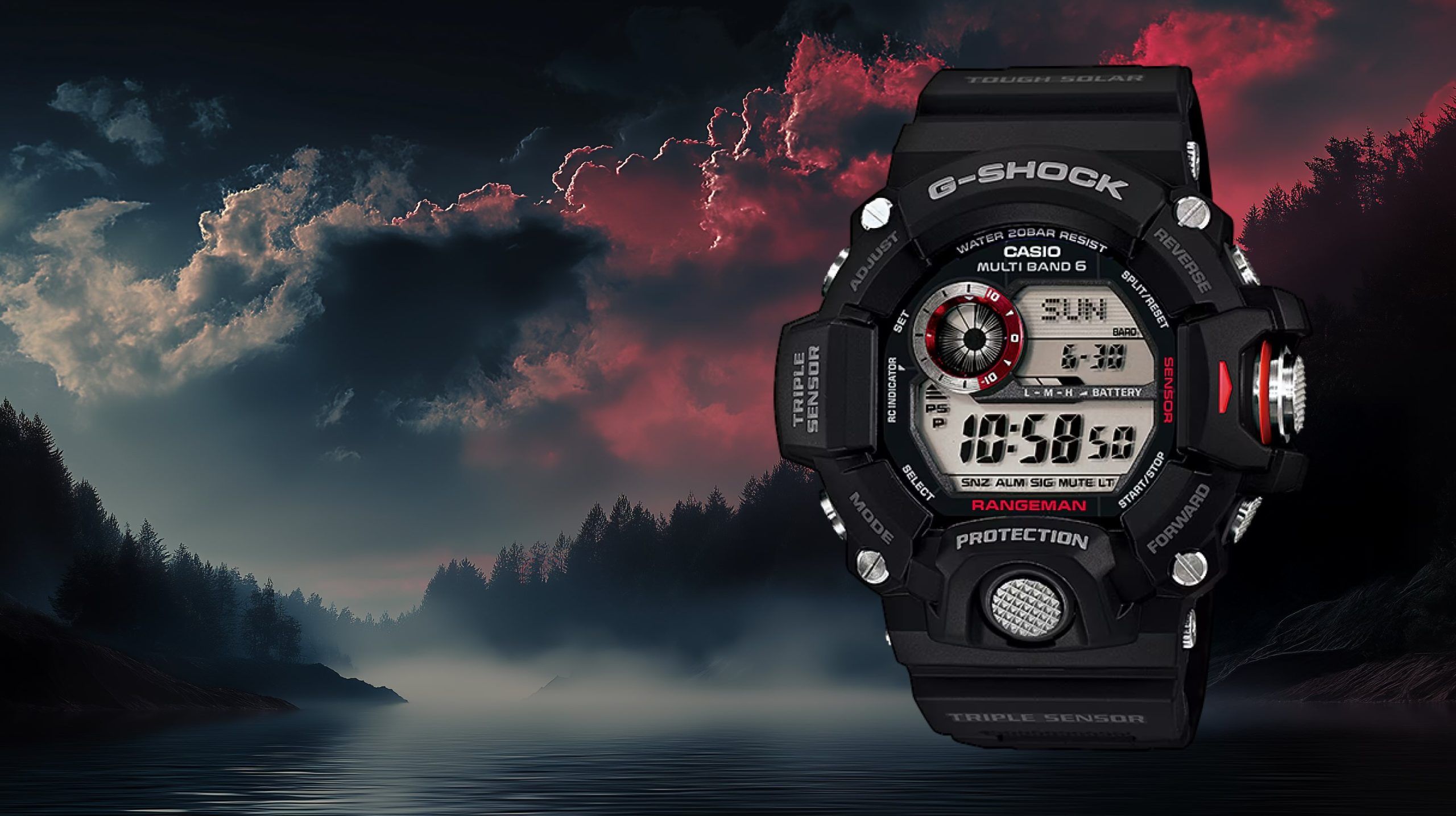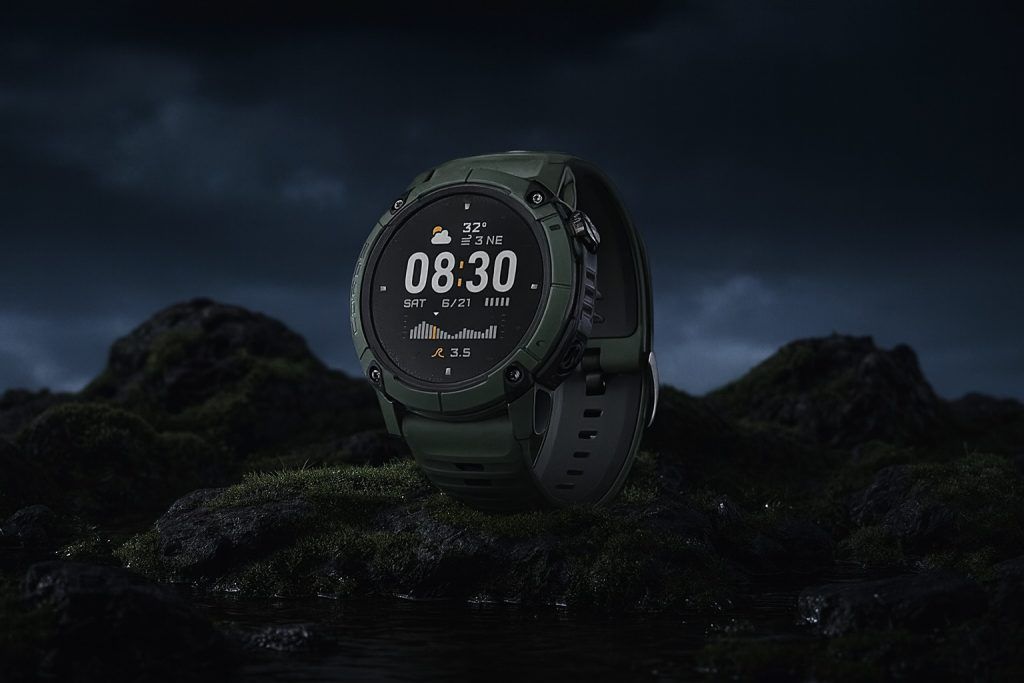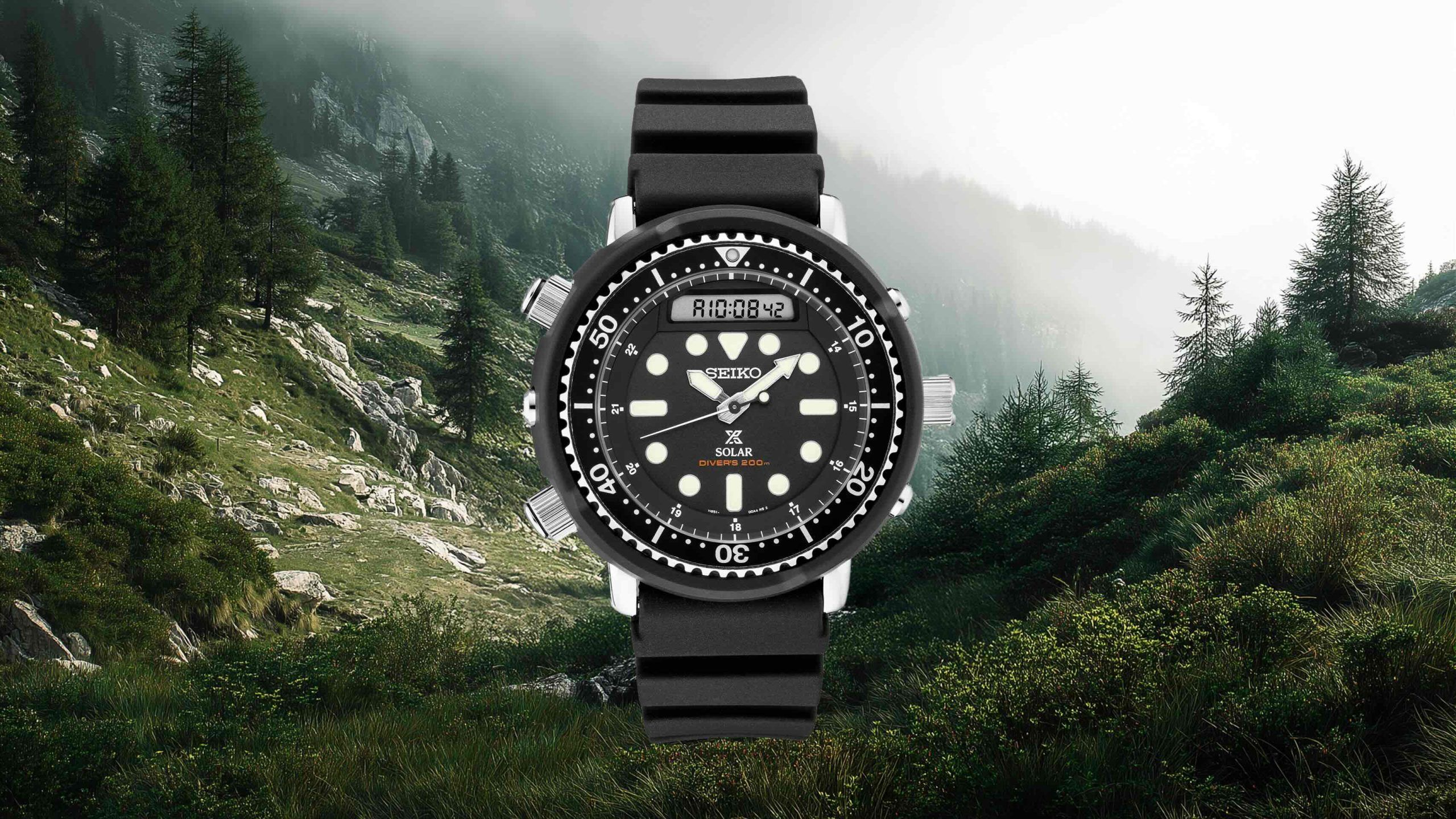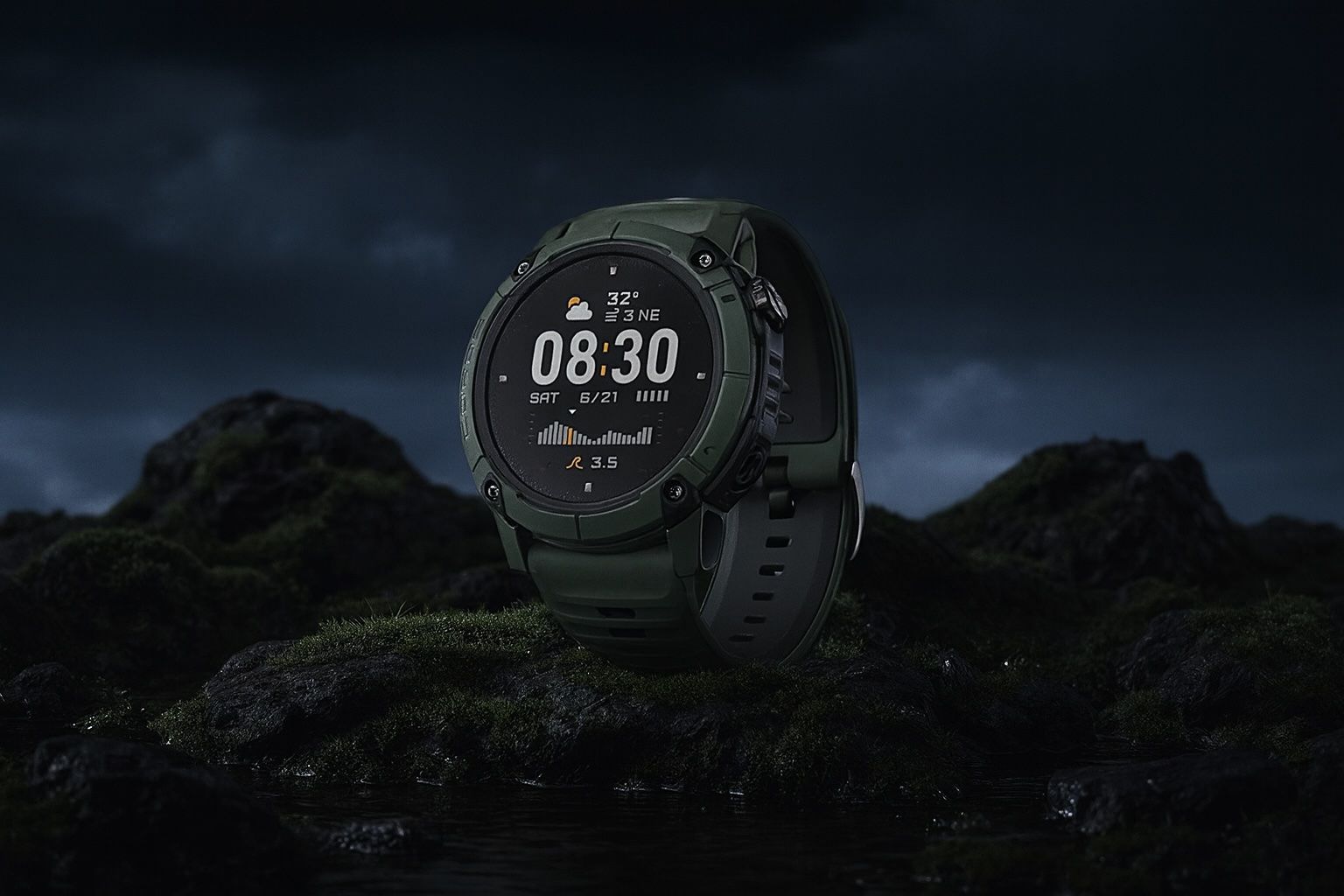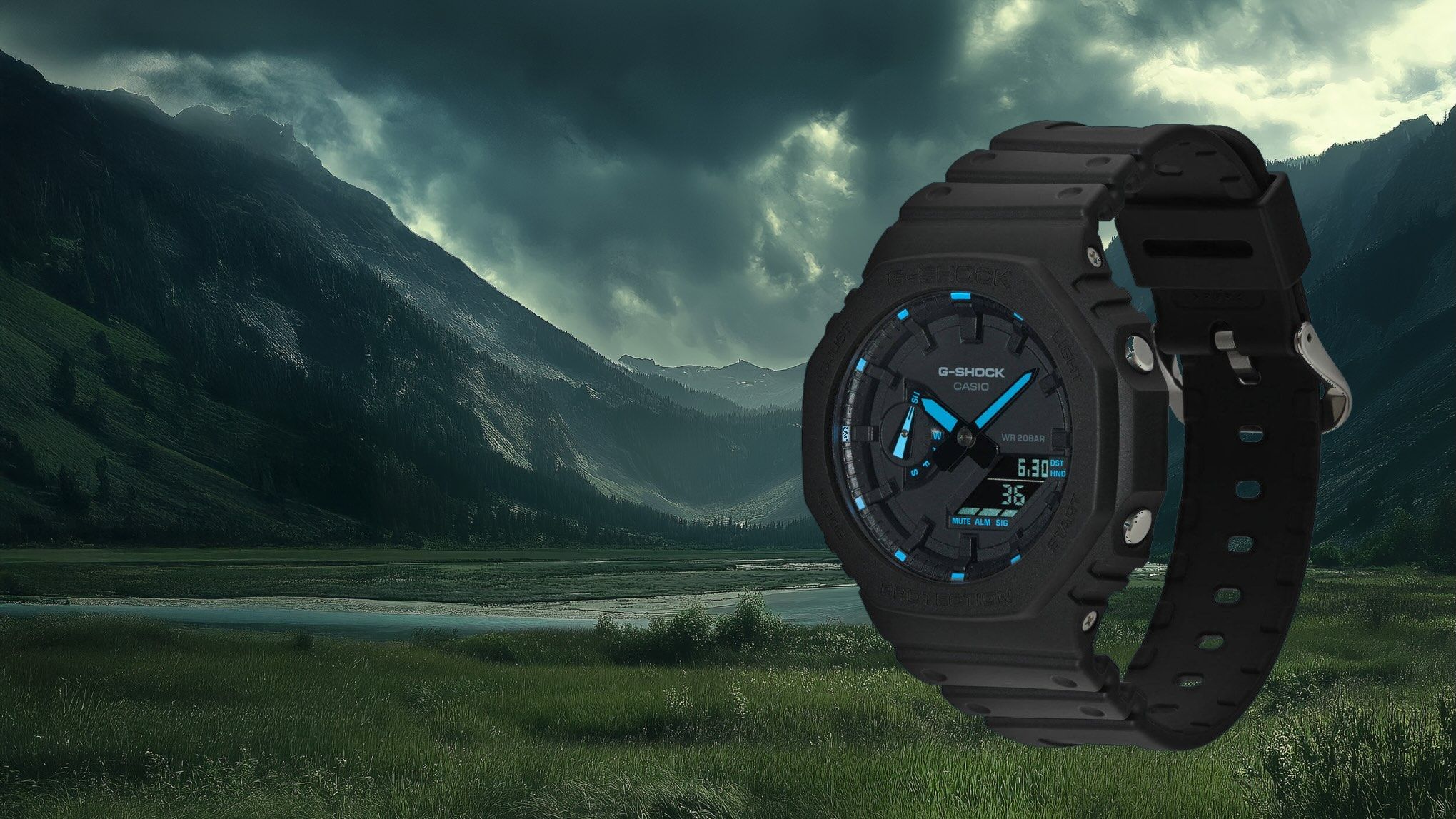- GW-9400 Rangeman (2013) introduced Casio Triple Sensor Ver.3 with Altimeter, Barometer, Compass and Thermometer in a 55 × 53.5 × 18.2 mm digital G-Shock, weighing about 93 g, with 200 m water resistance and Multi-Band 6 radio timekeeping.
- GPR-B1000 Rangeman (GPS) (2018) added standalone GPS navigation with up to 20 tracks and 60 points, Bluetooth to the Casio Watches app, and wireless charging, in a 60.3 × 57.7 × 20.2 mm case weighing about 142 g with sapphire crystal and 200 m water resistance.
- GWN-Q1000 Gulfmaster (2016) is an analog-digital hybrid with Quad Sensor including a depth gauge, in a 57.3 mm case, about 113 g, with carbon-reinforced resin, sapphire crystal, and 200 m water resistance, plus tide graph, moon data and sunrise/sunset times.
- The Gulfmaster adds Tough Movement with automatic hand correction, though early units suffered from hand drift that Casio addressed later.
- GW-9400 lasts about 8 months in darkness on a full charge thanks to Tough Solar and the CTL1616 cell.
- GPR-B1000 battery life allows about 33 hours of continuous GPS use from ~5 hours on the wireless charger, while timekeeping-only mode can run about 2 months on a charge when GPS is off.
- GWN-Q1000 battery performance is around 5–6 months in darkness on a full charge, with Power Save keeping energy use low and no GPS connectivity.
- GPR-H1000, announced in 2024, is the Rangeman successor with heart-rate monitoring and pulse oximeter, Bluetooth, GPS for location tracking but not full navigation, solar-assisted charging, and a launch price near $500.
- As of 2025, the GPR-B1000 and GWN-Q1000 have been discontinued while the GW-9400 remains in production in some regions.
- Ideal use cases: GW-9400 for land adventurers and rugged daily wear, GPR-B1000 for extreme expeditions with breadcrumb GPS and backtrack, Gulfmaster for maritime professionals needing depth, tide, and weather data.
Casio’s Master of G series includes some of the toughest and most feature-packed G-Shock watches designed for specific extreme environments. This report compares three notable models: the GW‑9400 Rangeman (a classic land survival watch), the GPR‑B1000 Rangeman (GPS-enabled advanced model), and the GWN‑Q1000 Gulfmaster (a marine-focused watch). We will examine their specifications, unique features, durability, real-world feedback, expert opinions, pricing as of 2025, use cases, and any recent developments.
Specifications at a Glance
The table below summarizes key specifications of the GW-9400, GPR-B1000, and GWN-Q1000:
| Feature | GW-9400 Rangeman (2013) | GPR-B1000 Rangeman (GPS) (2018) | GWN-Q1000 Gulfmaster (2016) |
|---|---|---|---|
| Design | Digital (LCD display) in rugged resin case [1] [2]. Triple Sensor (ABC). | Digital MIP LCD (high-res) display [3]. Very large resin/steel case with ceramic back [4]. Triple Sensor + GPS. | Analog + digital (STN LCD) display [5]. Large resin/stainless case with analog hands. Quad Sensor (ABC + depth) [6]. |
| Dimensions (H×W×T) | ~55.2 × 53.5 × 18.2 mm [7] | ~60.3 × 57.7 × 20.2 mm [8] | ~48.0 × 57.3 × 17.0 mm [9] |
| Weight | ~93 g [10] | ~142 g [11] | ~113 g [12] |
| Sensor Functions | Triple Sensor Ver.3: Altimeter, Barometer, Compass (+ Thermometer) [13] [14]. | Triple Sensor + GPS: Altimeter, Barometer, Compass (+ Thermometer) and GPS navigation [15]. | Quad Sensor: Altimeter, Barometer, Compass (+ Thermometer) and Depth Gauge (water depth) [16]. |
| GPS Capability | No | Yes – standalone GPS for location, track log, backtrack navigation [17] [18]. | No (relies on sensors and tide info for navigation). |
| Tide/Moon Data | Sunrise/Sunset times, no tide/moon graph (land-focused) [19] [20]. | Sunrise/Sunset times + Tide & Moon data (included for versatility) [21]. | Tide graph & Moon age data for marine use [22]. |
| Time Sync | Multi-Band 6 radio atomic sync (WWVB, JJY, etc.) [23] [24]. | Bluetooth smartphone link + GPS time-calibration (no radio) [25] [26]. | Multi-Band 6 radio sync [27] (no Bluetooth). |
| Power | Tough Solar rechargeable (CTL1616 battery) [28]; ~8 months on full charge (no light) [29]. | Solar-assisted + wireless charging [30]; ~33 hours GPS on full charge [31] (can extend 1 hour via 4h solar [32]). Timekeeping can run ~2 months per charge with sensors/GPS off [33] [34]. | Tough Solar rechargeable; similar multi-month reserve (official specs not published, but also CTL1616 battery). Depth sensor use will impact battery. |
| Water Resistance | 200 meters (20 bar) [35]. | 200 meters; + rated for mud, dust, and low-temp -20°C [36]. Ceramic caseback ensures water tightness [37]. | 200 meters; designed for ocean surface and diving up to 50m depth measurement [38]. Carbon-reinforced resin case for toughness [39]. |
| Durability Features | Shock Resistant; button guards (metal sensor button cover) [40] [41]. Not officially “mud-resistant”, but built for abuse. Mineral glass crystal. | Shock, mud, dust resistant [42]; Sapphire crystal and carbon fiber band [43]. Thick ceramic back for shock/waterproofing [44]. Built like a tank – virtually unbreakable [45]. | Shock Resistant; analog Tough Movement auto hand alignment to correct shock-induced misalignment [46]. Sapphire crystal (first Gulfmaster with sapphire) [47]. Carbon fiber reinforced case; “Neobrite” lumed hands/markers for night visibility [48]. |
| Connectivity | None (manual or radio sync only). | Bluetooth Low Energy to Casio app (for settings, log transfer, time sync). Wireless charging dock for battery [49]. | None (no Bluetooth; relies on radio sync for time). |
| Original MSRP | ~$300 (street prices ~$200-250). | ~$800 (¥100,000 JPY) at 2018 release [50]. (Discontinued in 2021 [51]) | ~$850 (¥100,000 JPY) at 2016 release [52] [53]. (Discontinued by ~2019 [54]) |
(ABC = Altimeter, Barometer, Compass; MIP = Memory in Pixel high-resolution LCD; STN LCD = super-twisted nematic LCD)
Design and Build Differences
Rangeman GW-9400: The GW-9400 is a purely digital watch with a classic G-Shock resin case and a single large LCD display. It introduced Casio’s Triple Sensor Ver.3 in a G-Shock, meaning it packs a tiny compass, altimeter-barometer, and thermometer sensor module despite its reasonable size [55] [56]. The design features a prominent center-right sensor button with a metal cover for protection, and it’s known for its intuitive layout – one press of the sensor button jumps into compass or altitude mode instantly [57] [58]. At 55×53.5 mm it’s large, yet many find it very wearable for a G-Shock. The GW-9400 uses a mineral glass crystal and a resin bezel; it is not marketed as “mud-resistant,” but like all G-Shocks it’s built to keep out most grit and water. The watch’s style is rugged and utilitarian – “one hard watch to beat” from a durability and functionality perspective [59]. Users often describe the Rangeman GW-9400 as feeling indestructible, surviving years of rough use “with barely a scratch” [60].
Rangeman GPR-B1000 (GPS): The GPR-B1000 takes the Rangeman concept and beefs it up significantly for the outdoors. Physically, it is one of the largest G-Shocks ever, about 60 mm across and 20 mm thick, weighing ~142 g [61]. It features a high-contrast MIP LCD screen (for detailed GPS info) rather than the segmented display of the GW-9400. The case integrates stainless steel, resin, and ceramic: notably a 2.0–2.3 mm thick ceramic caseback that enables Qi wireless charging and acts as a sturdy GPS antenna window [62]. The GPR-B1000 also has a sapphire crystal for scratch resistance and a carbon fiber-reinforced band [63]. It inherits full shock, dust, and mud resistance from Casio’s toughest lines; it’s rated for -20°C operation and 200 m water resistance [64]. Digital Trends noted it “has a 60mm case…big, bold, and built like a tank,” yet thanks to smart design (curved strap, wear it slightly loose) it is surprisingly comfortable for its size [65] [66]. The GPR-B1000’s design echoes the Mudmaster series and exudes an aggressive, tactical look – “cool, tough looks” as one reviewer put it [67]. With metal side “bumpers” protecting its sensors [68], this Rangeman is purpose-built to survive “all but the nastiest of accidents” [69].
Gulfmaster GWN-Q1000: The GWN-Q1000 is unique as an analog-digital hybrid in this trio. It has a traditional dial with analog hands plus a small LCD window, all in a large 57.3 mm case. Because it’s an ocean-oriented watch, the Gulfmaster’s build adds corrosion-resistant elements: a stainless steel bezel/frame over a carbon-reinforced resin case, and a soft urethane band for comfort even over a wetsuit [70]. It was the first Gulfmaster to get a sapphire crystal, acknowledging the harsher marine environment (sand, salt, impact) [71]. Notably, the Gulfmaster introduced Quad Sensor tech: along with the usual Triple Sensor, it includes a water depth sensor, visible as vertical slits on the case to let water in for pressure measurement [72]. This model is slightly thinner than the GPR-B1000 (17 mm vs 20 mm) and lighter, about 113 g [73], but still chunky and robust. Many design cues cater to marine use: large luminescent hands and markers (with NeoBrite lume) for legibility at sea, a tide graph subdial, and a blue bezel with numbered markers used for barometric pressure change indication [74] [75]. It also features Casio’s Tough Movement – an auto hand correction system that realigns the analog hands if shock or magnetism knocks them out of sync [76]. Early production runs had an issue with hand alignment drifting (requiring repair) but Casio corrected this in later units [77]. Overall, the Gulfmaster’s design blends the look of a serious analog dive watch with G-Shock’s bulky toughness – “sort of a dive watch, and sort of a hardcore marine-themed watch,” as one review described it [78].
The Casio G-Shock Gulfmaster GWN-Q1000 (black/blue and white/blue variants). This analog-digital model features quadruple sensors including a depth gauge for marine use [79] [80].
Sensors, GPS & Special Features
One of the biggest differences between these models is in their sensor arrays and navigation capabilities:
- GW-9400 Rangeman: Features Casio’s Triple Sensor Version 3 module, which provides an Altimeter, Barometer, Compass, and Thermometer readings in a compact form [81] [82]. This was cutting-edge for 2013, giving users on-demand direction, altitude, and weather info. The Rangeman records up to 40 timestamps of sensor data (with altitude, bearing, pressure, temp) via its One-Touch Time Stamp feature – handy for logging key points on a trek [83] [84]. It also includes sunrise/sunset times for a set location [85] and a barometric pressure change alarm that will notify the wearer of sudden weather changes (detected as spikes or drops in pressure) [86] [87]. What it lacks, given its age, are any GPS or sync features beyond the radio time-sync. This simplicity can be a plus in critical use: there’s no dependency on phone or signal, making it very reliable as long as it gets light for solar charging.
- GPR-B1000 Rangeman (GPS): In addition to also having the Triple Sensor (altimeter-barometer-compass) suite and thermometer [88], the GPR-B1000’s headline feature is its GPS navigation capability. It was the first-ever G-Shock with built-in GPS [89]. The watch can acquire your position coordinates and allows basic navigation on the watch display. Routes and Waypoints can be pre-planned in the G-Shock smartphone app or marked on the fly. The watch will display an arrow and distance to a destination or back to start (“Backtrack” function) using its LCD – essentially a breadcrumb trail navigator [90] [91]. Up to 20 tracks and 60 points can be saved in memory [92] [93]. There is no full map on the watch, but it provides directional guidance to points. In real-world use, owners note that GPS on the Rangeman is best for planned hikes – “It’s more of a breadcrumb trail… If you know you want to walk the trail and plan beforehand, you can have fun with it”, but it’s not a spontaneous turn-by-turn navigator like a smartphone GPS [94] [95]. The GPS can also sync time automatically, which is useful off the grid [96]. Uniquely, the GPR-B1000 includes tide and moon data (features borrowed from the Gulfmaster/Frogman realm) alongside sunrise/sunset info [97], making it a true multi-environment tool. It also has a Bluetooth link to connect with the Casio Watches app: this allows easier setting of alarms/worldtime and transfer of logged GPS tracks to your phone for viewing on a map. (The Bluetooth is low-energy with ~2m range [98]; essentially for data sync and settings, not continuous smartphone notifications – this is not a smartwatch, it’s a purpose-built adventure device.)
- GWN-Q1000 Gulfmaster: This model is all about marine sensors. Its Quad Sensor setup adds a Depth Gauge to the familiar trio of compass, barometer, and thermometer [99]. The depth sensor uses water pressure to measure diving depth up to 50 meters (in 0.1 m increments) [100], which is great for activities like snorkeling, free-diving, or shallow scuba. In fact, the Gulfmaster shares some tech with the dedicated Frogman dive series – it can track dive time and depth, though it’s not a full dive computer with decompression info. The barometer and compass are adapted for oceanic use: the compass has an automatic horizontal compensation (so it can be used on a rocking boat) [101], and the barometer can trigger a storm alarm (rapid pressure drop) to warn of bad weather [102]. A tide graph and moon phase display are on the dial, configurable by your known port/tide station [103]. The Gulfmaster also uniquely includes sunrise & sunset times (the first analog G-Shock to do so) to help plan daylight on the water [104]. One omission: the GWN-Q1000 does not have any connectivity or GPS, aligning with its mission as a reliable tool that doesn’t rely on external signals. It does, however, have the Multi-Band 6 radio receiver to keep its time accurate automatically each day [105] – a useful feature for global travelers at sea.
In summary, the GW-9400 and GWN-Q1000 rely purely on onboard sensors, while the GPR-B1000 augments sensors with GPS and connectivity. If you need navigation capabilities, the GPR-B1000 is the clear winner (with the caveat of pre-planning for best results) [106] [107]. For diving or marine operations, only the Gulfmaster can measure water depth and display tide/moon info on the wrist [108]. For straightforward hiking or military use, the simpler GW-9400 is valued for its proven sensor accuracy and minimal hassle.
Battery Life and Solar Charging
All three models use solar power, but their power management differs due to feature sets:
- GW-9400: Uses a small CTL1616 solar rechargeable cell. Thanks to its purely sensor + LCD module (no GPS, no Bluetooth), it achieves long autonomous run times: approximately 8 months of operation in the dark on a full charge (with normal use), or up to 23 months on full charge if stored with Power Save (display off) [109]. In practice, wearing it regularly outdoors means it rarely runs low; even indoor users report only needing to occasionally place it in sunlight. There’s a battery level indicator and it will warn if low [110]. Essentially, the GW-9400 is nearly maintenance-free – as long as you see some daylight every few months, the watch keeps running indefinitely. This reliability is a key reason it’s beloved by military personnel and adventurers who can’t fuss with charging [111] [112].
- GPR-B1000: Despite having Tough Solar, the power demands of GPS pushed Casio to include a wireless charging system. The watch comes with a wireless charging pad; a ~5-hour charge on this pad gives about 33 hours of continuous GPS use [113]. If you’re not using GPS, the solar alone can keep the watch going – in fact, users report that with infrequent GPS use, ambient light may suffice for many weeks [114] [115]. Casio built in a clever feature: if the GPS dies, expose the watch to bright sunlight and after ~4 hours, you get about 1 hour of GPS runtime back [116]. In pure timekeeping mode (sensors and GPS off), the GPR-B1000 acts like a normal solar G-Shock and can last up to 2 months on a charge [117]. However, using the GPS regularly means you’ll be recharging it more often – essentially it behaves like a hybrid between a standard G-Shock and a smartwatch. Importantly, the time display is always solar-powered no matter what [118] (so you won’t lose basic watch functions due to GPS drain). The watch’s app and firmware were updated by Casio to fine-tune power use. Real-world feedback indicates battery life is very good for most outdoor trips: “Battery life has been excellent. I only did the initial full charge… since then, solar only” (with light GPS use) [119]. Just remember to charge via USB or wireless before a long GPS-dependent expedition.
- GWN-Q1000: It also runs on Tough Solar and a CTL1616 cell, with no power-hungry radios. Its battery performance is comparable to other analog-digital G-Shocks (like the Mudmaster): generally several months to a couple of years per charge depending on sensor use. The analog movement and depth sensor add some load, so one can expect something like 5-6 months in darkness on full charge (Casio often specifies ~6 months normal / ~18 months in save mode for analog solar models). The Gulfmaster has a Power Save as well – it will shut off the digital display after a period in the dark to conserve energy. Notably, using the depth gauge or compass backlight frequently will consume more power, but in normal use users report the solar keeps up. There is a low-battery indicator and the second hand will start jumping to signal a low charge. Because it’s discontinued, one thing to consider is the battery’s age – by 2025, any original unit might benefit from a fresh CTL1616 cell if it doesn’t hold charge as well (these can be replaced by Casio service centers).
In all, solar charging is a major plus for these tough watches compared to full-fledged smartwatches. There’s no daily charging routine – GW-9400 and GWN-Q1000 essentially never need manual charging, and even the GPS Rangeman can go weeks of adventure with just occasional sunlight top-ups [120]. For extreme use (e.g. multi-week expeditions with heavy GPS use), the GPR-B1000’s wireless charger is an added piece of gear to carry, but one could also use a portable solar panel or battery pack to recharge it as needed.
Connectivity and Timekeeping
None of these watches are “smartwatches” in the modern sense, but the GPR-B1000 does have connectivity that the others lack:
- GW-9400 Rangeman: No connectivity. It keeps time accurate through Multi-Band 6 radio signal reception, syncing up to 6 times a day to atomic clocks (if you’re within range of one of the transmitters in North America, Europe, Japan, or China) [121] [122]. This means that in those regions, you never have to set the time or worry about drift (its quartz is ±15 sec/month if not synced [123]). For soldiers or travelers, this can be handy – you can trust the watch’s time down to the second as long as it syncs. If you’re out of range (or in a cave for weeks), you can always set it manually; it retains accuracy well on its own. There is no Bluetooth, no GPS time sync – purely the tiny radio receiver and Casio’s longwave signals which have worked reliably for decades.
- GPR-B1000 Rangeman: Offers two modern methods for timekeeping: Bluetooth sync to a phone (which in turn pulls internet time) and GPS signal time-calibration [124]. Whenever you connect it to the Casio G-Shock app, the watch can automatically set its time to match your phone’s network time. Additionally, if you are off-grid, the watch can use GPS satellites to sync time (this happens automatically when it detects GPS satellite availability) [125]. This is great for accuracy anywhere on Earth – effectively the watch carries its own atomic clock sync via GPS. It does not have the traditional Multi-Band 6 radio receiver (which wouldn’t work in e.g. the Southern Hemisphere or remote areas anyway), relying instead on these new methods [126]. The Bluetooth link also makes it easier to adjust world time cities, alarms, and settings through the smartphone interface. Once configured, the GPR-B1000 doesn’t need to stay connected to the phone – it’s generally a sync-then-disconnect usage. It’s worth noting that as of 2025, the original “G-Shock Connected” app that the GPR-B1000 used has been merged into Casio’s new Casio Watches app; some users have reported quirks during this transition (like needing firmware updates or that certain old features like map view have changed) [127]. But the core time-sync and logging features remain supported.
- GWN-Q1000 Gulfmaster: No Bluetooth or GPS. Like the GW-9400, it relies on Multi-Band 6 radio calibration for set-and-forget timekeeping [128]. This is especially useful for a watch that might be used on maritime deployments across time zones – if you’re near a transmitter at night, it will auto-adjust to local atomic time. If not, manual adjustment is always available (and straightforward via the crown). The analog movement also has the cool feature that if the hands are misaligned (due to a strong shock or magnetism), the watch will auto-correct them (by referencing the digital time) – ensuring the analog hands always display the correct time and sensor readings [129].
Overall, connectivity is a major differentiator: if you want a G-Shock that can interface with your phone or use GPS for time, the GPR-B1000 is in a different league. However, the flip side is simplicity: many users appreciate that the GW-9400 and GWN-Q1000 have no app dependency or firmware updates to worry about – their features will work the same in 10 years as they do today, as long as the watch is running. The GPR-B1000 sits in between a traditional G-Shock and a smartwatch, and Casio has managed to include connectivity without compromising its legendary toughness.
Real-World User Feedback and Reliability
All three models have been tested in harsh conditions by thousands of users. Here are some highlights of user reviews and reliability reports:
- GW-9400 Rangeman: The Rangeman has arguably reached “legendary” status among G-Shock fans for its unfailing reliability. Owners routinely share stories of brutal treatment: “This watch has taken a beating and still works and looks as new as the day I took it out of the box. Been plunged underwater almost daily, taken baby crap and vomit, had a hard fall in mud, several bangs against door posts, etc., and there’s barely a scratch!” [130]. After 6+ years of daily use, many report it still looks nearly new and all functions work flawlessly [131]. Its accuracy is excellent (especially when syncing via radio) and even without sync it holds time well. The triple sensor is generally praised for providing readings in line with dedicated instruments (with the known caveat that the thermometer needs to be off-wrist to measure air temperature accurately). A Reddit user who wore the GW-9400 daily for years across “from sports and gym to working as a mechanic, from going into beaches to sub-0°C mountain weather” expressed that it never let him down [132]. There are few negatives: some mention it’s a large watch (long lug-to-lug span) so small-wristed people find it big – but others counter that it “hugs the wrist” and is comfortable even on smaller wrists because of its curved back and strap. The negative LCD version (GW-9400-1B) has a dimmer display, which a few users find less legible, but the standard positive display GW-9400 is very easy to read. In terms of durability, the resin band and bezel can eventually show wear after years (and are replaceable), but the module and sensors seem nearly bombproof. As one reviewer said: “From durability, functionality, and style, this is one hard watch to beat” [133]. The GW-9400’s long track record in military use (often cited as a top choice under $300 for soldiers [134]) and outdoor adventures speaks to its trustworthiness.
- GPR-B1000 Rangeman: User impressions of the GPR-B1000 often start with its size – it’s universally called a “hockey puck” on the wrist [135]. However, those who own it quickly follow up that it’s “an amazing watch” in capability [136] and is surprisingly wearable if you are used to G-Shocks. One owner said “sometimes I just get in the mood and wear it for a few weeks at a time”, acknowledging it’s large but still enjoyable day to day [137]. In terms of functionality, GPS performance has mixed feedback: technically it works as advertised – it will track your route and help you backtrack – but some found the implementation clunky or expected more. “GPS probably isn’t what you think it is; it’s used more as a breadcrumb trail rather than something on a smartphone,” one user explained, cautioning that it’s not a full map navigator [138]. If you plan routes in the app and load them, the system is much more effective. The connectivity to the phone generally works, though a few note the watch can be finicky about needing open sky for GPS sync and even Bluetooth connection (for example, one said “it really likes to be in as open an area as possible or it just won’t connect [GPS] in a mildly covered area” [139]). Battery life in real scenarios seems to align with Casio’s claims or even exceed expectations: one user reported never having to do a second wireless charge in regular use – solar was enough except when doing continuous GPS logging [140]. The toughness of the watch is unanimously lauded – with its sapphire crystal, ceramic back, and armored build, people have not reported any breaking or water ingress issues at all. “You’re not going to break this watch,” Digital Trends stated after testing it in wilderness conditions [141]. Some owners lament that the model was discontinued, saying they “wish they still made it”, as it has become somewhat of a collector’s piece. On the used market, it still commands high prices, which is a testament to its niche but solid reputation. The main downsides noted are: the price (it was $800 new, which is steep – “expensive” as DT’s pros/cons list noted [142]), and the bulk (not for everyone’s daily wear under a cuff). But in its intended role – “the watch that should be on your wrist when you’re in the wilderness” [143] – users say the GPR-B1000 absolutely delivers the robustness and autonomy needed.
- GWN-Q1000 Gulfmaster: The Gulfmaster Quad Sensor had a more limited user base (being a pricey analog G-Shock), but feedback from owners is generally positive regarding its functionality. Many praise it as “the most advanced G-Shock for the sea”, noting that if you really need the combined altimeter, compass, and depth abilities, it’s fantastic. Professional users like coast guard personnel appreciated features like the level-compensated compass and fast-response barometer. The depth gauge is reportedly accurate for free-diving and spearfishing purposes, and several divers used it as a backup device to track their depth and dive time. One owner on an enthusiast forum wrote: “Yes it is big, but very comfortable to use and gosh, it is beautiful. …This one got me. I am an analog guy and this is like a dive watch on steroids” [144]. As mentioned, early reliability issues did crop up: some of the first units had analog hands that would drift off zero (especially after temperature swings or impacts). Casio addressed this by adding the automatic hand correction and refining the assembly; by the time of the later variants (like GWN-Q1000A in 2018), reports of this issue largely vanished [145]. Owners of those later models report “many have no complaints or hand issues” [146]. The watch’s size and weight are a common theme: at ~152 g (some sources cite higher weight likely with composite bracelet) it’s heavier than a typical resin G-Shock [147] [148]. It definitely requires a big wrist or a taste for big watches [149]. A 6’2” tall user noted it was a good fit for him and incredibly solid, but someone with a 6” wrist felt it was overkill. The analog display means you must sometimes use the crown to scroll hands out of the way to see the LCD (for example, to read the digital depth or tide info) – a minor inconvenience. However, the analog format also gives it a distinctive appeal; unlike the purely digital Rangemans, the Gulfmaster can pass as a (very rugged) analog watch at a glance, which some users prefer for style. In terms of durability, aside from the early hand-sync hiccups, it’s a true G-Shock – built tough. The carbon reinforced case and steel bits mean it handles impacts and even some knocks against rocks on dives without issue. The resin band on this model is long (to fit over wetsuits) and some found it a bit too long for everyday wear if you have smaller wrists (the strap tail sticks out). A solution for some was switching to the optional composite bracelet (Casio released a version with a hybrid metal-resin bracelet [150]), which improved comfort and premium feel. With the model being discontinued, a few fans on Reddit wonder if Casio will ever revisit the Gulfmaster concept – “I’d love Casio to release a new Gulfmaster, but between the manufacturing defects and the small audience, I wonder if they ever will” one wrote in 2021 [151]. Despite the discontinuation, those who have the GWN-Q1000 generally treasure it for what it is: a unique, fully-loaded maritime G-Shock that “will prove its seaworthiness to the most demanding users” [152].
In summary, all three models have proven reliable in their domains. The GW-9400 is often called the most reliable “beater” G-Shock – you can thrash it and it shrugs it off [153]. The GPR-B1000 brought unprecedented tech to G-Shock without compromising toughness, but it asks the user to understand its GPS limitations to get the most out of it (those who bought it expecting a Garmin-like experience had to adjust their expectations) [154]. The GWN-Q1000 had a rocky start but ended up a highly capable tool, now serving a niche group of users (and collectors) who value its ocean-going talents. It’s worth noting that because two of these models are discontinued, long-term support (like battery replacements, spare parts) will eventually become an issue, but Casio typically supports models for many years. As of 2025, service centers can still repair or refurbish GW-9400s and GWN-Q1000s readily, and parts like straps, bezels, and batteries are available. The GPR-B1000, being newer, is also serviceable, though its unique wireless charger should be kept safe (a replacement charger costs around $120 if lost, one user pointed out [155]).
Expert Opinions and Reviews
Reputable watch reviewers and publications have weighed in on these models, often praising their innovation and toughness:
- Casio GW-9400 Rangeman: “The best and most fully-featured G-Shock watch to date. Great design on top of that,” wrote A Blog To Watch when the Rangeman was released [156]. ABTW and others highlighted that Casio managed to pack almost every major G-Shock feature (solar, atomic time, triple sensor, etc.) into one model without the price becoming exorbitant (it stayed in the mid-$200s). The only drawback noted was its size: “Worst characteristic: Not the smallest G-Shock model around.” [157] Yet, that size is also what gives it such presence and durability. Outdoor Gear Lab, in testing the GW-9400 against other hiking watches, gave it high marks for battery life and ruggedness, commenting that “it’s insanely accurate and almost impossible to break” [158]. Numerous G-Shock aficionados rank the Rangeman as a top Master of G; G-Central (a fan site) notes the GW-9400 is one of the most popular Master of G watches ever, attributing its success to the “combination of legendary toughness and practical sensors at an accessible price” [159]. It frequently appears in “best G-Shock” lists as a recommended watch for military, search-and-rescue, and outdoor sports [160] [161].
- Casio GPR-B1000 Rangeman (GPS): This model garnered attention in mainstream tech media due to its pioneering features. Digital Trends did a hands-on review, coming away impressed: “A simple control system, solar charging, and built-in GPS make the Casio Rangeman a versatile tough watch for weekend-long trips into the wilderness.” [162] They listed its pros as being “the toughest watch out there,” with the GPS+solar combo, wireless charging, and surprisingly simple menu controls as major positives [163]. The cons were its large size and high price [164]. Digital Trends summed it up by saying the GPR-B1000 “should be on your wrist when you’re in the wilderness,” underlining that it’s not meant to compete with an Apple Watch for daily wear, but to outperform everything when things get extreme [165]. A Blog To Watch praised Casio’s achievement in making the first GPS watch that could recharge via solar, calling it a “very satisfying hybrid between a smartwatch and a traditional G-Shock” – essentially a go-anywhere tool that doesn’t suffer the typical smartwatch’s battery anxiety [166]. Another expert reviewer from ocabj.net noted it “wears comfortably” despite the size and that Casio “did a good job designing [the strap] for such a large watch”, but also mentioned that if one buys it just for the GPS navigation feature, they might be disappointed because “it’s VERY sluggish” compared to handheld GPS units [167]. This aligns with user advice that the GPR-B1000’s GPS is best viewed as a safety backup or basic nav aid, not a full navigation device. Overall, experts regard the GPR-B1000 as a milestone for Casio – it proved that even a GPS tool watch can remain solar-powered and ultra-rugged [168]. Its discontinuation in 2021 was attributed by some to Casio focusing on other projects (like the WearOS GSW-H1000 smartwatch) [169], but the GPR-B1000’s influence lives on in the new generation (see the GPR-H1000 below).
- Casio GWN-Q1000 Gulfmaster: A Blog To Watch did a detailed review of the Gulfmaster, highlighting its uniqueness. They described the GWN-Q1000 as “sort of a dive watch, and sort of a hardcore marine-themed watch”, pointing out that what separates it from other G-Shocks is its look and analog functionality [170]. The review noted that “Casio is capable of both innovation and function” at a high level in this watch, essentially bridging the gap between a traditional analog dive watch and a digital sensor watch [171] [172]. ABTW praised the improved comfort of the integrated strap design (long for wetsuits yet contoured) and the value of having depth, compass, and barometer on one device for maritime professionals [173] [174]. On the critical side, they mentioned the watch is “not suitable for everyone’s wrists” due to the size, and that it “requires a big wrist or a preference for big watches” [175]. They also appreciated the high-tech touches like sapphire crystal and titanium components that keep weight reasonable for its size (the stated weight in their review unit was 152 g, which they attributed to the titanium case parts) [176] [177]. In conclusion, expert consensus is that the GWN-Q1000 is a formidable instrument for seafaring: G-Central called it “a significant upgrade… that will prove its seaworthiness to the most demanding maritime users” [178]. The main reason it didn’t become as famous as the Rangeman is likely its niche appeal and high price; but within its niche, it’s considered one of the most capable analog sensor watches ever made. With the Gulfmaster series on hiatus, some experts point out that Casio’s Frogman series now covers some of that domain (the analog Frogman GWF-A1000 lacks a depth gauge, while the older digital Frogman GWF-D1000 had depth+compass but is also discontinued). As such, the GWN-Q1000 remains a high-water mark (pun intended) for Casio’s ocean watches.
Pricing and Availability (2025)
As of 2025, the landscape for these models is: one is still in production in various forms (the GW-9400), while the other two have been officially discontinued but can be found on the market.
- Casio GW-9400 Rangeman: Price: The Rangeman’s price has held steady in the ~$200–$300 range for years. Its MSRP was around $300 in the US, but street prices for the basic black model are often around $220. Special color editions (like the “Desert Tan” or camo versions) may cost a bit more, and the all-black GW-9400-1B with negative display also hovers in that range. It’s widely available at retailers, both online and brick-and-mortar (Casio still lists it on their site and it’s often in the “Best Sellers” section of G-Shock). Availability: Fully in production (2025) – Casio shows the GW-9400 in its catalog, and G-Central confirmed that even as of 2021, Casio Japan was still producing the Rangeman GW-9400 models due to sustained demand [179]. You can buy it in North America, Europe, and Asia easily. In different regions it may have slightly different suffixes (e.g. GW-9400-1ER in Europe, GW-9400J-1JF in Japan), but it’s essentially the same watch. Given its popularity, even if Casio ever “retires” it, inventory will likely be around for a long while. Beware of fakes: because the Rangeman is popular, there are some counterfeit G-Shocks out there – always purchase from authorized dealers or reputable sources.
- Casio GPR-B1000 Rangeman: Price: Originally $800 (¥100,000 in Japan, £799 in UK, €799 in Europe) [180], this was a premium product. After a couple of years, some retailers dropped prices to ~$600–$700, but it never saw massive discounts because of limited supply. Once discontinued (circa 2021), new stock became scarce. In 2025, you will generally find the GPR-B1000 on the secondary market. Prices vary: a mint condition full set can still fetch $500–$600. Used ones sometimes go for less; for instance, one user bought a used unit from Japan for about $614 [181]. We’ve even seen a few listings in the sub-$500 range if the watch has cosmetic wear or is missing the charger. Speaking of which: ensure any purchase includes the proprietary wireless charger – it’s essential, and buying it separately from Casio is costly [182]. Availability: Officially discontinued. Casio stopped production of the GPR-B1000-1 in Japan by April 2021 [183], and no variants remain in production [184]. In the US, it lingered at some retailers through 2022, but by 2025 it’s not in Casio’s catalog. Your best bet is second-hand platforms (eBay, watch forums). There is still a steady trickle of units being sold by collectors or stores clearing old stock. The GPR-B1000 came mainly in two variants: the standard black (GPR-B1000-1) and a green/black limited edition (GPR-B1000-3 “Safari” edition). Both are equally functional; the green may be slightly rarer. If buying used, as with any high-end G-Shock, check that the sensor functions and charging work correctly. The lithium battery inside should still have good life (only ~7 years since release), but heavy GPS use could degrade it slightly. Fortunately, Casio designed it to be replaceable by service centers if needed.
- Casio GWN-Q1000 Gulfmaster: Price: The Gulfmaster Quad Sensor was an expensive watch new – around $850 (in Japan ¥100k, in US $850 as announced) [185]. It did not sell in huge volumes, so it rarely saw big discounts either. By the time of its discontinuation, some retailers in Asia cleared remaining stock in the ~$600 range, but in regions where it was scarce, prices even went up for new pieces. In 2025, it’s hard to find new. Occasionally a new-old-stock GWN-Q1000 appears (perhaps in Japan) and might still be around list price. On the used market, they appear sporadically – one might find a good condition piece for $500–$700 depending on variant and completeness. Some limited editions (like the Coast Guard Rescue Red edition, or the “Love The Sea and The Earth” Greenpeace edition GWN-Q1000K-7A) can fetch higher values among collectors. Availability: Discontinued (series ended). Casio quietly discontinued the Gulfmaster GWN-Q1000 series a few years after release [186]. G-Central reported that by 2019, the last model in production (the GWN-Q1000A-2AJF, a blue-accent version) was also halted [187]. As of 2025, Casio’s official sites no longer list Gulfmasters. If you’re looking to buy one, your avenues are second-hand dealers, watch forums, or possibly Japanese auction sites (the model was more available in Japan). Keep in mind that being analog, if you get an early unit, ensure the analog hand alignment is correct (when in compass mode, the second hand should point to 12 o’clock when level). If not, the movement may need recalibration – something Casio service can do. Because the Gulfmaster wasn’t as big a seller, spare parts like bezels or bands might be limited, but third-party straps or adaptors might exist. Given its water-focused nature, check the condition of gaskets if buying used, especially if the watch was actually dived with.
Regional availability: The GW-9400 is easily found in North America, Europe, and Asia (it was even officially sold in markets like India, Middle East, etc., as part of Casio’s lineup). The GPR-B1000 had a global release as well, but being more niche, some smaller markets never stocked it widely (buyers imported it). The Gulfmaster GWN-Q1000 had a staggered release – Japan got it first, then select Asian markets and Casio America did a limited release of the black version in 2016 [188]. Europe also had it in limited quantities (some countries like the UK listed the GWN-Q1000-1A). By late 2010s, it was mostly found in Japan/Asia. So if you’re hunting for one in 2025, you may end up looking at Japanese sources.
One additional note: Casio’s warranty typically is region-specific and around 1-2 years. Obviously for discontinued models that time has passed, so any purchase now is usually as-is (unless you buy from a dealer offering their own warranty). Fortunately, Casio watches in this range are generally reliable; just make sure to test all sensor functions on arrival.
Ideal Use Cases for Each Model
Each of these G-Shocks excels in different scenarios. Here’s a summary of which watch might be “best for” various uses:
- GW-9400 Rangeman – Best for Land Adventurers and General Outdoor Use: This model is a favorite of military personnel, hikers, backpackers, hunters, and survival enthusiasts. Casio itself markets it as “the perfect choice for rangers, rescue crews, and anyone else whose activities demand unfailing reliability.” [189] The combination of toughness, ease of use (one-button direct sensor access), and the lack of dependency on anything (no charging cable, no phone) makes it superb for long deployments in remote areas. Many soldiers choose the GW-9400 for field ops because it’s one less thing to worry about – it charges itself and gives useful info like direction and weather trends. It’s also relatively affordable to replace if it gets lost or stolen. The Rangeman is also a great all-purpose G-Shock for those who want a bit of everything: alarm, stopwatch, world time, and sensors in one package for everyday wear in tough jobs (construction, law enforcement, etc.). It’s overkill if you just need a timepiece, but for anyone who finds altimeter/compass useful occasionally and likes a “go anywhere” watch, the Rangeman is a classic choice. Its style – black, chunky, digital – is iconic G-Shock. It’s not a dress watch by any means, but you’ll see them on wrists from the outback to urban jungles on people who prioritize function and durability.
- GPR-B1000 Rangeman (GPS) – Best for Extreme Outdoor Expeditions and Tech-Savvy Explorers: This watch was designed with the image of someone doing a multi-day trek, or an off-road rally, or a search-and-rescue operation in mind. It’s ideal for backcountry explorers, mountaineers, and survivalists who go out of cellphone range and still want the safety net of a GPS breadcrumb trail and location logging. For example, if you’re navigating dense wilderness with no map signal, the Rangeman GPR-B1000 can record your path and help you backtrack if needed – a significant safety feature [190]. It’s been used by adventurers in places like the Sahara and Siberia where charging an Apple Watch is not feasible, but a solar G-Shock can thrive. It’s also a great tool for researchers or military teams that might want to mark coordinates of points of interest with a simple button press (it stores lat/long along with temp/altitude at that point [191]). The GPR-B1000 is also a bit of a collector’s item now for G-Shock aficionados – tech-wise it was ahead of its time. That said, it’s not the best for someone who wants daily fitness tracking or smartwatch features – Casio has other models (like the GBD-H1000 or newer GPR-H1000) for fitness metrics. The GPS Rangeman shines when you need absolute ruggedness with occasional GPS navigation in scenarios where charging or carrying a separate device is impractical. Consider it the watch for expedition leaders, desert rally drivers, or emergency preppers who might say: “I want a watch that can guide me out if all else fails.” It’s also worth noting the GPR-B1000’s navigation interface, while simple, means you’re focusing on basics like bearing and distance – some old-school navigators (ex-military, etc.) appreciate that style vs. relying on detailed maps.
- GWN-Q1000 Gulfmaster – Best for Maritime Professionals and Water Sports Enthusiasts: The Gulfmaster was literally introduced with a scenario of “coast guard personnel and others active on the sea” [192]. It is tailor-made for mariners – sailors, coast guard, navy, marine researchers, fishermen – basically anyone who spends a lot of time on the ocean or large lakes. The combination of tide info, compass with level correction, barometer for weather, and depth gauge is extremely useful on a boat. For instance, a sailor can use the barometer trend to predict a storm, the compass to check bearings if electronics fail, the depth gauge when navigating shallow waters or diving overboard, and the tide/moon data to plan operations. The Gulfmaster is also a great companion for divers and snorkelers, especially free-divers who don’t use SCUBA – it will tell you how deep you went and how long you were under (up to 100 minutes dive timer) [193]. Divers who have used it praise that it’s like having a backup analog dive watch with depth readout – they still use a dedicated dive computer for serious diving, but the G-Shock provides an extra layer of data (and of course, being a G-Shock, can handle the bumps and scratches that might crack a dive computer screen). Surfers or beach lifeguards could also benefit from the tide graphs and sunset times to know when conditions change. In daily life, the Gulfmaster’s analog look can be an advantage – it doesn’t scream “tech gadget”, so some professionals wear it in uniform or on duty where a full-digital watch might look out of place. It is a conversation piece due to its size and complexity; a Gulfmaster on the wrist signals that you’re serious about your marine gear. Given its discontinuation, it’s now also a watch for collectors of rare G-Shocks, especially those who want the full Master of G “set” or admire its engineering (four sensors in an analog watch was a first). A final niche: those who live in coastal areas prone to hurricanes or storms may like the Gulfmaster as a sort of “early warning” device – the pressure alarm can literally alert you to a sudden drop that could indicate a squall or cyclone coming [194] [195], which on the ocean could be life-saving.
In essence, if you’re in the mountains or battlefield, pick the Rangeman; if you’re traversing uncharted terrain, the GPS Rangeman; if you’re out on the open sea, the Gulfmaster. Each is specialized, though all retain versatility. It’s not unheard of for serious adventurers to own multiple – e.g., a user might take a Rangeman on a mountain hike but switch to a Gulfmaster for a sailing trip.
Current Developments and Future Models
As of 2025, there have been some exciting developments in the G-Shock Master of G line that are worth mentioning, especially for those looking toward the future:
- New Rangeman GPR-H1000 (2024): After a few quiet years, Casio unveiled a next-generation Rangeman at CES 2024 – the GPR-H1000 [196] [197]. This model builds on the GPR-B1000, essentially merging it with modern fitness smartwatch features. Notably, the GPR-H1000 includes a heart-rate monitor and pulse oximeter, along with the traditional triple sensor and GPS [198] [199]. It’s like Casio took the lessons from their GBD-H1000 G-Squad fitness watch (which had heart-rate, step counter) and fused that with a Rangeman. The GPR-H1000 has Bluetooth connectivity and can track workouts (running, swimming, etc.) using Polar’s algorithms for fitness metrics [200] [201]. It retains GPS for positioning (though notably, reviews mention it does not have the full navigation features of the GPR-B1000 – it’s more for location/route tracking and fitness stats, not on-screen backtrack navigation, which G-Central listed as a con: “no GPS navigation features” in the H1000) [202]. It remains solar-assisted (solar charges timekeeping, but you still use USB for the main battery) [203]. Importantly, Casio greatly reduced the price – the GPR-H1000 launched at $500 (versus $800 for the old one), indicating Casio’s intent to compete in the outdoor smartwatch market [204]. The watch is just as tough: shockproof, 200m water resistant, with a new mud-resistant design (improved button sealing) [205]. In fact, it’s being marketed as possibly “the toughest smartwatch on earth” [206]. If you’re considering a Rangeman in 2025, the GPR-H1000 is worth a look – it’s essentially the new flagship “Land” Master of G. However, it serves a slightly different use-case than the GPR-B1000: more focus on training and health (heart rate, recovery, etc.) in addition to survival features, whereas the B1000 was more pure survival/navigation. For someone torn between a Garmin and a G-Shock, the new Rangeman tries to offer a bit of both. Early hands-on impressions (Tom’s Guide, etc.) are positive, noting its ability to track activities like trail runs, hikes with metrics like elevation gain, heart rate, VO2 max estimation, etc., all while maintaining G-Shock durability [207] [208]. The addition of global tide data also means it even encroaches a bit on the Gulfmaster’s territory for water sports [209].
- No New Gulfmaster (yet): Unfortunately for fans of the Gulfmaster, Casio has not announced a direct successor to the GWN-Q1000. The Master of G Sea category recently has been represented solely by the Frogman series (in 2020 Casio released a Bluetooth-connected analog Frogman GWF-A1000, but that lacks depth sensor; it’s more of a dive-style watch with tidal data). The discontinuation of the Gulfmaster line suggests Casio might have felt the market for an all-in-one maritime sensor watch was too limited. There have been rumors in enthusiast circles about a possible Gulfmaster revival or a new Frogman with more sensors, but nothing concrete as of 2025. Some leaks in late 2024 indicated Casio was focusing on updating the Mudman and Mudmaster (land series) and Gravitymaster (air series) next, rather than the Sea series. It’s possible Casio might incorporate depth or tide features into a future Frogman rather than resurrect the Gulfmaster name. In the meantime, those duties are spread across models: e.g., the Rangeman GPR-H1000 includes tide/sun data for surfers, and Frogman covers diving. If maritime professionals need a current model, they often go with Pro Trek (Casio’s outdoor line) or dedicated dive computers, as the Gulfmaster is no longer in production. Still, given Casio’s penchant for surprises, one can’t rule out a Master of G return to the sea – perhaps a “smart Gulfmaster” could appear if there’s demand.
- Firmware Updates: Neither the GW-9400 nor GWN-Q1000 have firmware to update (they are not user-updateable). The GPR-B1000 did receive at least one firmware update early in its life, improving connectivity and GPS efficiency. By 2025, Casio’s support page indicates that the latest firmware is required to use the newer “Casio Watches” app – owners should check if their GPR-B1000 has the latest module software, especially if encountering app connection issues [210]. The new GPR-H1000, being more complex, will likely see occasional firmware updates for bug fixes and feature tweaks (Casio provided updates to its GBD-H1000 and GSW-H1000 regularly). So, prospective buyers should be aware that the landscape is shifting towards semi-smart G-Shocks that do have an update cycle.
- Regional Discontinuations: We noted earlier that GPR-B1000 and GWN-Q1000 were discontinued. It’s worth adding that even the GW-9400 Rangeman has some signs of winding down: in Japan, Casio has a practice of marking models “End of Production” when they stop making them. As of 2021, Japan still produced the Rangeman [211], but we’re now over a decade since its debut. Casio has introduced a new Mudman (GW-9500 in 2023) and a new Mudmaster (GWG-B1000 in 2023) with updated tech, but an updated “basic” Rangeman (GW-9400 replacement) hasn’t come yet. It might be that the GPR-H1000 is considered the successor in spirit. If Casio discontinues the GW-9400 in the next couple of years, expect a surge of interest from enthusiasts grabbing the remaining stock – much like what happened with the Mudman GW-9300 when it was ended. For now, you can still readily buy a GW-9400 new, but it’s something to watch. The GPR-B1000, as discussed, is already gone – interestingly, it was relatively short-lived (about 3 years in production). The Gulfmaster GWN-Q1000 lasted only ~3 years in production too. The GW-9400 is the longevity king here, going strong 10+ years.
- Special Editions and News: As of 2025, Casio continues to release special color variants of G-Shocks. In early 2025, a “Rescue Yellow” Master of G series was leaked, which reportedly includes a Rangeman in bright yellow along with Mudman and Gravitymaster models [212]. This could be a new GW-9400 variant or possibly a GPR-H1000 in yellow (Casio did release the GPR-H1000 in a black and a yellow version at launch [213] [214]). These themed releases (like Love The Sea and The Earth editions, anniversaries, etc.) sometimes give a last hurrah to a model. For instance, Casio did a 35th anniversary “Magma Ocean” Rangeman GW-9400 in 2018 [215]. Collectors might be interested in grabbing these as they often become rare.
- Competitive Landscape: It’s not a development from Casio per se, but it’s relevant that Garmin, Suunto, and others have very strong offerings in the outdoor watch space by 2025. Garmin’s Fenix and Instinct series, for example, are solar-charging GPS watches with loads of sensors (including things Casio now has like heart rate, and things Casio still doesn’t like two-way satellite comms). Casio seems to be responding by hybridizing their G-Shocks (the new Rangeman being a prime example). For die-hard G-Shock fans, nothing beats the build quality and the assurance that no matter what, your watch won’t die on you quickly. But new buyers will compare something like the GPR-H1000 vs a Garmin Instinct 2 Solar, etc. This competition is driving Casio to innovate, which is good news. We may see future Master of G models with even more capabilities (who knows, maybe a built-in satellite messenger or something one day).
In conclusion, the Casio G-Shock GW-9400, GPR-B1000, and GWN-Q1000 each represent Casio at its best in their respective arenas – land, multi-tech, and sea. They have proven themselves through real-world abuse and earned praise from experts and users alike. While two of them are now “legacy” models, they remain highly relevant and coveted in 2025. And with Casio’s recent and upcoming releases, the spirit of these watches – ultimate toughness, sensor-rich functionality, and go-anywhere reliability – continues to evolve. As one expert succinctly put it when reviewing the Rangeman: “Will they get better in the future? Probably, but [the Rangeman] is one hard watch to beat.” [216]. That future is now arriving, but the legacy of these models assures them a place in the hall of fame of outdoor watches.
Sources:
- Casio G-Shock GW-9400 Rangeman official specifications [217] [218] [219]
- Casio G-Shock GPR-B1000 Rangeman press release and specs [220] [221] [222]
- Casio G-Shock GWN-Q1000 Gulfmaster announcement and details [223] [224] [225]
- G-Central G-Shock fan site – news on discontinuations and model information [226] [227]
- Reddit r/gshock – user reviews of Rangeman GW-9400 and GPR-B1000 [228] [229]
- Digital Trends – hands-on review of GPR-B1000 Rangeman [230] [231]
- Tom’s Guide – CES 2024 coverage of new Rangeman GPR-H1000 [232] [233]
- Millenary Watches – review of Gulfmaster GWN-Q1000 (features and case) [234] [235]
- A Blog To Watch – commentary on Rangeman GW-9400 and Gulfmaster GWN-Q1000 [236] [237]
- G-Central – “20 Best G-Shock” list with Rangeman GPR-H1000 and GW-9400 context [238] [239]
- Casio official press info and G-Shock catalog data [240] [241].
References
1. www.casio.com, 2. www.casio.com, 3. shockbase.org, 4. gshock.casio.com, 5. shockbase.org, 6. www.g-central.com, 7. www.casio.com, 8. shockbase.org, 9. shockbase.org, 10. www.casio.com, 11. shockbase.org, 12. shockbase.org, 13. www.casio.com, 14. www.casio.com, 15. www.g-central.com, 16. www.g-central.com, 17. gshock.casio.com, 18. gshock.casio.com, 19. www.casio.com, 20. www.casio.com, 21. www.g-central.com, 22. www.g-central.com, 23. www.casio.com, 24. www.casio.com, 25. www.g-central.com, 26. gshock.casio.com, 27. www.g-central.com, 28. shockbase.org, 29. www.casio.com, 30. gshock.casio.com, 31. gshock.casio.com, 32. gshock.casio.com, 33. www.tomsguide.com, 34. www.tomsguide.com, 35. www.casio.com, 36. gshock.casio.com, 37. gshock.casio.com, 38. millenarywatches.com, 39. www.g-central.com, 40. www.casio.com, 41. www.casio.com, 42. gshock.casio.com, 43. gshock.casio.com, 44. gshock.casio.com, 45. www.digitaltrends.com, 46. millenarywatches.com, 47. www.g-central.com, 48. www.g-central.com, 49. gshock.casio.com, 50. shockbase.org, 51. www.g-central.com, 52. www.g-central.com, 53. shockbase.org, 54. www.g-central.com, 55. www.casio.com, 56. www.casio.com, 57. www.casio.com, 58. www.casio.com, 59. www.ablogtowatch.com, 60. www.reddit.com, 61. shockbase.org, 62. gshock.casio.com, 63. gshock.casio.com, 64. gshock.casio.com, 65. www.digitaltrends.com, 66. www.digitaltrends.com, 67. www.digitaltrends.com, 68. www.tomsguide.com, 69. www.tomsguide.com, 70. www.g-central.com, 71. www.g-central.com, 72. millenarywatches.com, 73. shockbase.org, 74. www.g-central.com, 75. www.g-central.com, 76. millenarywatches.com, 77. www.g-central.com, 78. www.ablogtowatch.com, 79. www.g-central.com, 80. www.g-central.com, 81. www.casio.com, 82. www.casio.com, 83. www.casio.com, 84. www.casio.com, 85. www.casio.com, 86. www.casio.com, 87. www.casio.com, 88. www.g-central.com, 89. www.g-central.com, 90. gshock.casio.com, 91. gshock.casio.com, 92. gshock.casio.com, 93. gshock.casio.com, 94. www.reddit.com, 95. www.reddit.com, 96. www.g-central.com, 97. www.g-central.com, 98. gshock.casio.com, 99. www.g-central.com, 100. millenarywatches.com, 101. www.g-central.com, 102. millenarywatches.com, 103. millenarywatches.com, 104. www.g-central.com, 105. www.g-central.com, 106. www.reddit.com, 107. www.reddit.com, 108. www.g-central.com, 109. www.casio.com, 110. www.casio.com, 111. www.ablogtowatch.com, 112. www.reddit.com, 113. gshock.casio.com, 114. www.reddit.com, 115. www.reddit.com, 116. gshock.casio.com, 117. www.tomsguide.com, 118. gshock.casio.com, 119. www.reddit.com, 120. www.reddit.com, 121. www.casio.com, 122. www.casio.com, 123. www.casio.com, 124. www.g-central.com, 125. gshock.casio.com, 126. www.g-central.com, 127. www.reddit.com, 128. www.g-central.com, 129. millenarywatches.com, 130. www.reddit.com, 131. www.reddit.com, 132. www.reddit.com, 133. www.ablogtowatch.com, 134. www.watchuseek.com, 135. www.reddit.com, 136. www.reddit.com, 137. www.reddit.com, 138. www.reddit.com, 139. www.reddit.com, 140. www.reddit.com, 141. www.digitaltrends.com, 142. www.digitaltrends.com, 143. www.digitaltrends.com, 144. www.ablogtowatch.com, 145. www.g-central.com, 146. www.reddit.com, 147. millenarywatches.com, 148. millenarywatches.com, 149. millenarywatches.com, 150. www.g-central.com, 151. www.reddit.com, 152. www.g-central.com, 153. www.reddit.com, 154. www.reddit.com, 155. www.reddit.com, 156. www.ablogtowatch.com, 157. www.ablogtowatch.com, 158. robmancini.com, 159. www.g-central.com, 160. www.g-central.com, 161. www.g-central.com, 162. www.digitaltrends.com, 163. www.digitaltrends.com, 164. www.digitaltrends.com, 165. www.digitaltrends.com, 166. www.ablogtowatch.com, 167. www.watchuseek.com, 168. www.g-central.com, 169. www.g-central.com, 170. www.ablogtowatch.com, 171. millenarywatches.com, 172. millenarywatches.com, 173. millenarywatches.com, 174. millenarywatches.com, 175. millenarywatches.com, 176. millenarywatches.com, 177. millenarywatches.com, 178. www.g-central.com, 179. www.g-central.com, 180. shockbase.org, 181. www.reddit.com, 182. www.reddit.com, 183. www.g-central.com, 184. www.g-central.com, 185. www.g-central.com, 186. www.g-central.com, 187. www.g-central.com, 188. www.g-central.com, 189. www.casio.com, 190. gshock.casio.com, 191. gshock.casio.com, 192. www.g-central.com, 193. millenarywatches.com, 194. www.casio.com, 195. www.casio.com, 196. gshock.casio.com, 197. www.reddit.com, 198. www.tomsguide.com, 199. www.tomsguide.com, 200. www.tomsguide.com, 201. www.tomsguide.com, 202. www.g-central.com, 203. www.tomsguide.com, 204. www.tomsguide.com, 205. www.tomsguide.com, 206. www.tomsguide.com, 207. www.tomsguide.com, 208. www.tomsguide.com, 209. www.tomsguide.com, 210. www.reddit.com, 211. www.g-central.com, 212. www.notebookcheck.net, 213. www.tomsguide.com, 214. www.tomsguide.com, 215. www.g-central.com, 216. www.ablogtowatch.com, 217. www.casio.com, 218. www.casio.com, 219. www.casio.com, 220. gshock.casio.com, 221. gshock.casio.com, 222. www.g-central.com, 223. www.g-central.com, 224. www.g-central.com, 225. www.g-central.com, 226. www.g-central.com, 227. www.g-central.com, 228. www.reddit.com, 229. www.reddit.com, 230. www.digitaltrends.com, 231. www.digitaltrends.com, 232. www.tomsguide.com, 233. www.tomsguide.com, 234. millenarywatches.com, 235. millenarywatches.com, 236. www.ablogtowatch.com, 237. www.ablogtowatch.com, 238. www.g-central.com, 239. www.g-central.com, 240. gshock.casio.com, 241. shockbase.org
